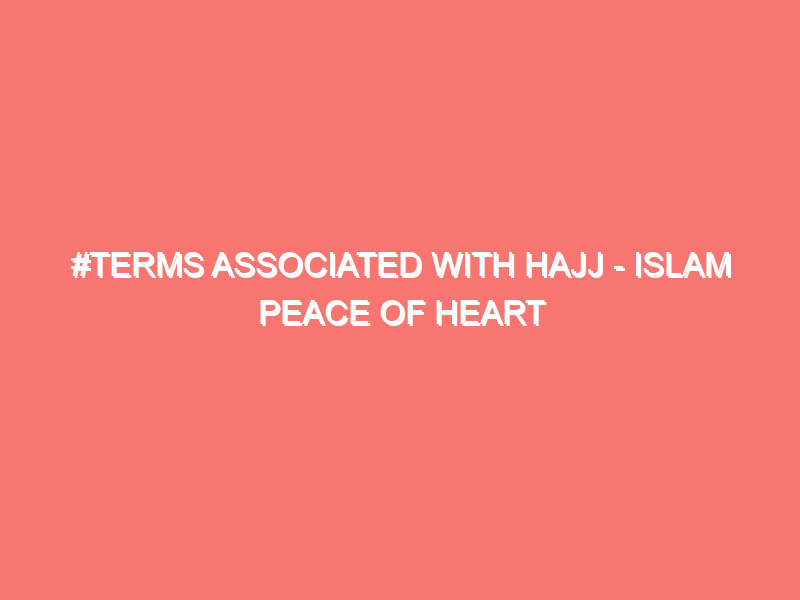Terms associated with Hajj
1) Ka’abah
Ka’abah, the holiest and most sacred place for Muslims, is that the first house on earth built for the worship of 1 Allah. in step with tradition, it absolutely was constructed by angels, nearly two thousand years before the creation of Adam. When Adam was sent to earth the angels indicated to him the precise location where this House had to be reconstructed. The Ka’abah was destroyed by flood during Hazrat Noah’s time. it had been then constructed again by Hazrat Ibrahim and his son Hazrat IsmaiLAt one place, -in the Quran, Allah has called it “My House” and, at another place, He has called Himself ‘Rabb of this House’. There are twenty-four gates through which this House is also entered, but it’s better for the pilgrim to enter through Bab-as-Salam. Since the times of Hazrat Ibrahim, people are coming to the Ka’abah for Umrah or Hajj.
2) There are strict rules for the preservation of the sanctity of Ka’abah. For this purpose, several circles are drawn round the Ka’abah.
a) Masjid-e-Haram:
The first and innermost circle is named Masjid-e-Haram or the Sacred Mosque. the world of the Sacred Mosque contains, besides the Ka’abah, the Maqam-e-lbrahim and also the building over the well of Zam Zam. The offering of 1 Farz prayer within the sacred Mosque is capable 100 thousand prayers as reward. (Islam: A Comprehensive Guide Book. Altaf Ahmad Kherie)
Read More:
‣ Hajj
‣ Zakat
b) City of Makkah:
The second circle is named Makkah Mukaramma, town Of Makkah. it’s an area of peace- and security within which all living things are shielded from violence. If anyone seeks asylum in Makkah, he can not be captured or killed. The hunting or killing of any bird or animal is prohibited, even the cutting of its trees and grass is forbidden.
c) Haram:
The third circle is named Haram. Its boundaries were fixed at Allah’s command first by Hazrat Adam and than by Hazrat Ibrahim. The Holy prophet pbuh had pillars erected to point the boundaries of Haram.
d) Mawaqit:
The fourth circle is named Mawaqit. These are the places beyond which nobody proceeding to Makkah for Hajj and Umrah can proceed without putting on the Ihram, otherwise, he shall should offer a sacrifice as penalty.
Hajr-e-Aswad — Black Stone:
Mounted in silver and set within the southeastern corner of the Ka’abah is that the sacred Black Stone, Hajr-e-Aswad received by Hazrat Ismail from the angel Jibrael during the re-building of the traditional House. in step with tradition, this stone was milky white; it’s become black due to the sins of individuals. This holy •stone was touched or kissed by Hazrat Ibrahim and by the Holy prophet PbUh. Its kissing is symbolic of pure love of Allah and our resolve to obey Him all told matters.
Well of Zam Zam:
This well is within the southeastern side of Masjid-e-Haram. The spring that feeds this well sprang up from under the feet of Ismail, when his mother Hajra, was attempting to find water for her infant son between the Safa and Marwa hills. From that point till the current day, ample people have drunk the water of this well.
Read More:
‣ Fasting
‣ Salat
Maqam-e-lbrahim or the station of Ibrahim:
This is a stone on which Hazrat Ibrahim stood while constructing the Ka’abah. The Wajib-ut-Tawaf prayers are offered near Maqam-e-lbrahim.
Hatim:
This is atiny low area between Rukn-e-Shami, the corner facing Syria and RUkn-e-Yemeni, the southwestern corner of the Ka’abah. it absolutely was originally a component Of the Ka’abah but wasn’t included within the covered enclosure, The offering Of Prayers within the Hatim is held to be like offering prayers inside the Ka’abah.
Read More:
‣ Shahadat
Ihram:
The Ihram for men consists of two white sheets of unsewn cloth. One sheet is employed for covering the lower portion of the body, from the navel downwards and therefore the other is employed for covering the upper portion of the body. the top remains uncovered.
The Ihram for ladies is their everyday clothes. it’s compulsory for girls to hide their heads, but no cloth should touch their faces.
Ihram first and foremost Farz of Hajj and Umrah. it’s a declaration of one’s intention or niyat to perform Hajj or Umrah. Ihram is that the visible indication or symbol of the pilgrim’s renouncing all the vanities of the globe to devote himself to the worship of Allah. Ihrain may be a time of forbearance and patience. It . symbolises purity, renunciation and also the equality and brotherhood of all believers.
Talbiyah:
Talbiyah is that the proclamation of the subsequent words: “Here i’m at Thy service; O Allah! Here i’m at Thy service. there’s no partner with Thee, Here in at Thy service. All praise and. all blessing and favours belong to Thee, and all Sovereignty is Thine. Thou hast no partner”
From his entry into the state of Ihram till the stoning of-the first Jamarat at Mina, on the 10th of Zil Hajj, the pilgrim constantly recites the Talbiyah. it’s to be recited by men in an exceedingly fairly loud voice. The Holy Prophet PbUh said; “Jibril came to me to convey Allah ‘s message that I should command my followers to recite Talbiyah during a loud voice” (Tirmizi).
The Talbiyah is to be recited morning and evening while sitting, standing, walking, riding, after the regular prayers and on every change of posture. “On each occasion, it’s to be recited twice. The pilgrim isn’t to speak to anyone while reciting it, nor should someone greet him and he’s not excepted to return the greetings.
The recitation of Talbiyah implies that the pilgrim presents himself wholeheartedly before Allah with no other thought than the Divine encounter. His cry of recognition of Allah and what He has revealed pledges him to a sustained and ever-renewed devotion.
